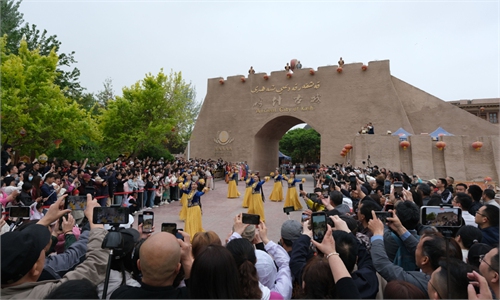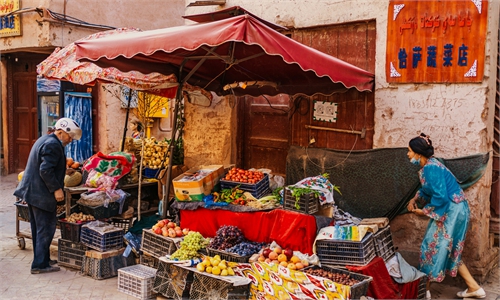ARTS / CULTURE & LEISURE
Explore the real Xinjiang: A place with development and harmony, say foreign experts who have visited the region
A place with devt and harmony, say foreign experts who have visited the region

The Multicolored Beach in Altay, the Xinjiang Uygur Autonomous Region Photo: VCG
Editor's Note:Some Western media outlets have been persistently fabricating misleading narratives concerning Northwest China's Xinjiang Uygur Autonomous Region. Following claims of "genocide" and "forced labor" in the region, they have recently begun portraying China as attempting to "erase Uygur culture." These anti-China forces, many of whom have never set foot in Xinjiang, are trying to smear China's image with baseless accusations.
In contrast, international scholars who know and have visited Xinjiang in person have shared their observations about the region's development over the years, showing otherwise. During a recent forum titled "The History and Future of Xinjiang, China," which attracted more than 170 experts and scholars from China and abroad, several scholars spoke to reporters about the changes they have witnessed in Xinjiang and shared their various perspectives on the region.
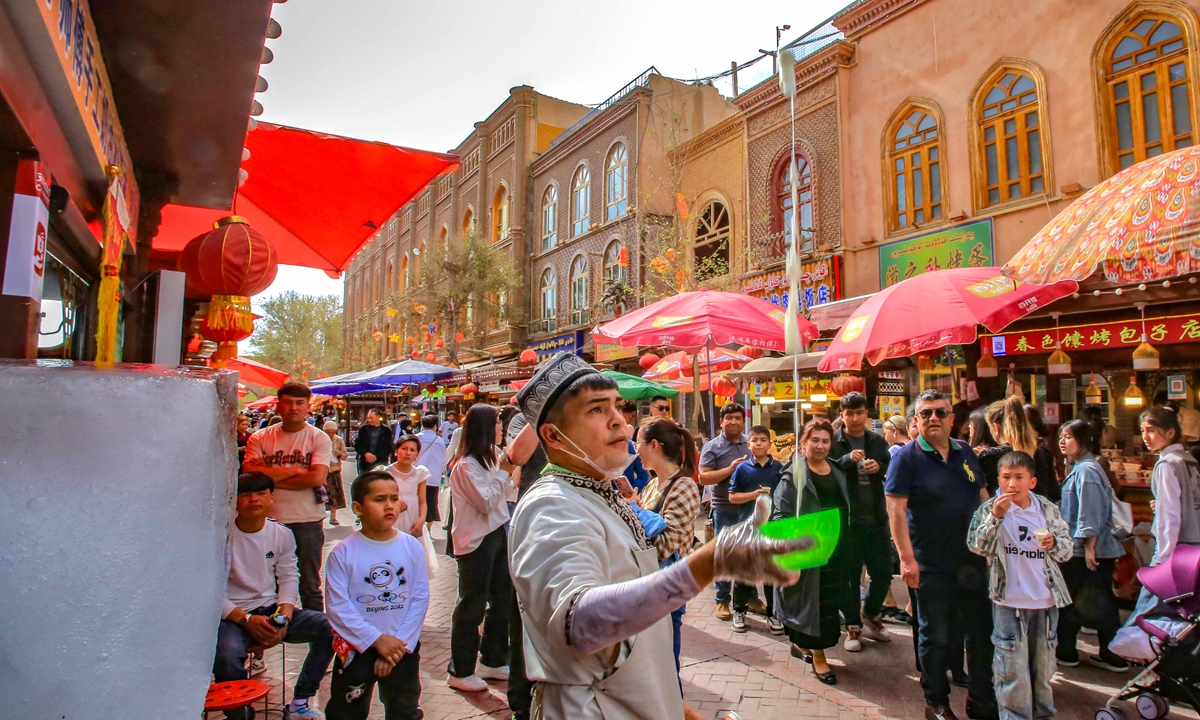
A vendor in the Ancient City of Kashi makes ice yogurt for customers. Photo: VCG
Colin Patrick Mackerras, an Australian sinologist and emeritus professor at Griffith University, has written two books about ethnic minorities in China: China's Ethnic Minorities and Globalisation and China's Minority Cultures: Identities and Integration since 1912. Both books cover a considerable amount of content about the ethnic minorities in Xinjiang. Having visited Xinjiang many times over the past decades, Mackerras is a true eyewitness to the region's development."I first came to Xinjiang in 1992. I've been here several times since then. My impression is that the standard of living has risen enormously, but the poverty has gone down," Mackerras told the Global Times on the sidelines of the "The History and Future of Xinjiang, China" international forum. The forum was held on June 12 in Kashi, Xinjiang.
Kashi, in particular, left him with an impression of a modern city with excellent public services. The old areas of the city were much cleaner and tidier than during his last visit, but still very well preserved the Uygur style and culture.
There are some untruthful statements in the West, claiming that the cultures of local ethnic minorities are being destroyed and obliterated. Judging from his own experience, Mackerras firmly refuted such ridiculous accusations.
"I don't see the evidence of that," Mackerras said, pointing to local art, architecture and food among the many signs. He noted that the cultures of local ethnic minorities have been very well preserved.
"I see people are very keen on the Uygur performing arts and that Uygur music is continually performed both by professionals and by ordinary people. I think that's a good thing."
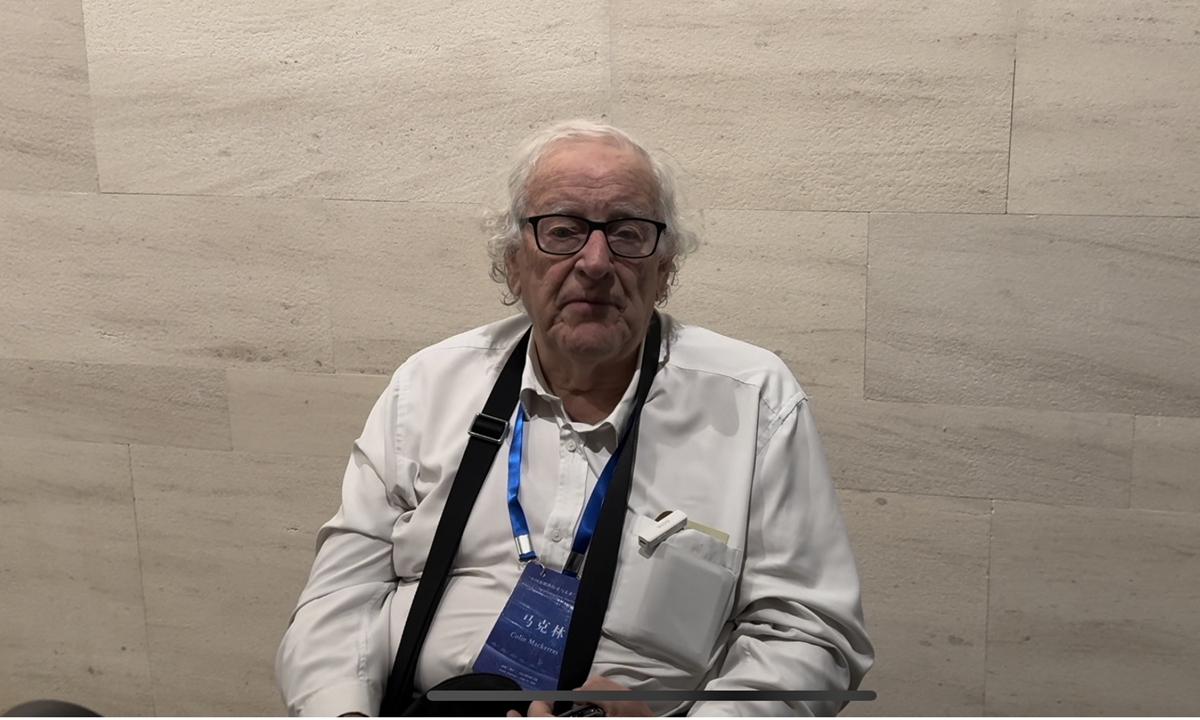
Colin Patrick Mackerras Photo: Bi Mengying/GT
Mackerras has visited Shache county in Kashi several times, with the most recent visit being in 2018. He recalled that this small town has a beautiful ancient mosque next to a park, which contains a mausoleum commemorating Amannisa Khan, a respected cultural figure of the Uygur people responsible for collecting and preserved the Uygur musical legacy known as the "Twelve Muqam."The Twelve Muqam, regarded as the mother of Uygur music, is a musical form that combines sung poetry, storytelling and music. This tradition, like many others in Xinjiang, is being preserved and passed down to future generations.
During his stay in Shache, he visited a school that trains performers in Uygur dance and the Twelve Muqam, which left a very deep impression on him. During his speech at the forum, he shared his experience visiting the school and the photos taken during his visit with forum attendees. He said that all these efforts reflect local authorities in Xinjiang's emphasis on the protection of traditional ethnic minority cultures.
"And the Uygur language seems to me to be used very widely. People talk in the West about how it's being stamped out, but that's just not the case. If you compare the use of indigenous languages in China, specifically Uygur, with the use of indigenous languages in Australia or the US, it's far more in China," Mackerras told the Global Times.
The Chinese government formally kick-started the Western Development Strategy in January 2000 to help underdeveloped western region catch up with the more prosperous eastern region. This strategy has achieved great success. From any angle of economic development, Xinjiang has performed excellently in recent years, Mackerras said.
At the same time, the significant improvement in indicators such as the completion rate of nine-year compulsory education, the gross enrollment rate at the high school level, and average life expectancy also indicate a substantial improvement in people's livelihoods.
"There is also a modernization process and modernization processes affect how people think. It affects what people wear. It affects all kinds of things," noted Mackerras.
"But there is also retention of culture. And the retention of the most important pictures of culture, which include things like languages and art and architecture and food. Those things matter to people. And I think the idea that it's being eradicated, is just nonsense. That's not what I see."
To refute these untruthful accusations in the West, Mackerras called for further people-to-people exchanges, which he said are the key to deepening mutual understanding.
He suggested that tourism would be a good option to facilitate exchanges. More Australians should visit China and see China with their own eyes, so that they can better understand the country.
"One of the things that worries me in Australia at the moment is that the China Studies in universities are not doing particularly well. In fact, it's gone down. I think that's a great shame because we should be understanding China more, we should be training people who can understand China more. I think that there's a lot of work to do in that regard," said Mackerras.

The grand bazaar in Urumqi Photo: VCG
'Come and see for yourself'Mary Tucker-Grim is a professor at the School of Forestry and Environmental Studies of Yale University. Her husband John Grim is a senior lecturer and senior researcher at the school. Both of them participated in the international forum, where they gave speeches.
In 1993, the couple came to Kashi for the first time by train. Tucker-Grim recalled that it was a very "difficult" trip. "We even had a sandstorm where for many hours we were stuck with the sand sweeping across the desert," she told the Global Times.
Grim recalled that many years ago, he saw a bustling cattle and sheep market in Kashi. He found the shouts of sellers and scenes of local people trading horses, camels and sheep very lively and interesting.
This time coming to Kashi, they took a plane.
"I saw so much more green. There was so much more irrigation and growing of crops. And I'm sure agriculture has expanded in the region," said Grim.
According to Grim, China's pursuit of energy transition is very inspiring. While achieving rapid economic development, it also focuses on environmental protection, setting an example for the whole world.
"And now we come in 2024, and there is so much development, and it's really wonderful to see this kind of progress, where people's lives are made easier and there is employment and there's a sense of sharing cultural ideas with a larger world. These are all really significant," he said.
"The ecological civilization and the contribution of the cultures, worldviews of this great civilization are important," Tucker-Grim told the Global Times.
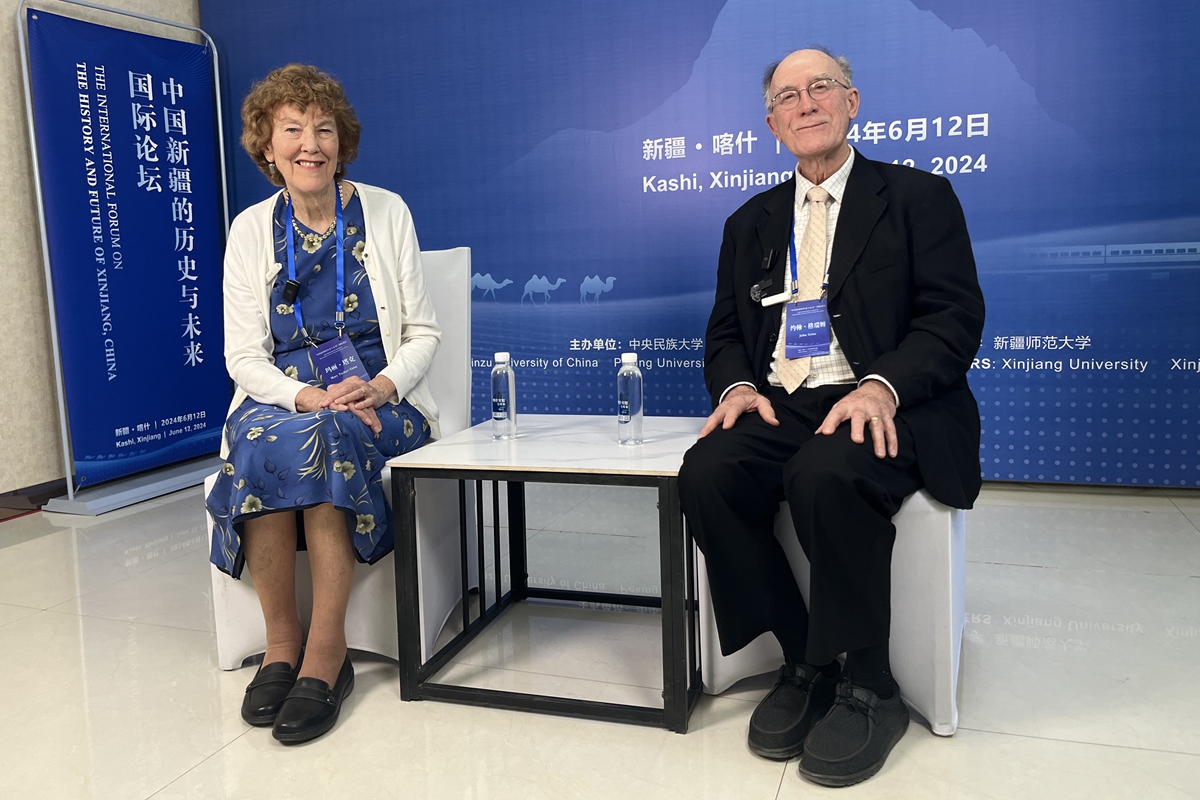
Mary Tucker-Grim (left) and John Grim Photo: Li Hang/GT
She holds the view that "China is one of the few places in the world that can talk about culture, civilization, deep time of history. And that is very impressive. It's unique and something that the whole world needs to understand, keeping alive culture, tradition, opening it up.""At the same time, our expectation is that this devotion to history is also a devotion to modernity in terms of the future of your generation and your children and our students at Yale," she said when talking about her expectations for this trip to Xinjiang.
While Grim thinks that his expectations for this trip have been "met," "I think it's very good for Mary, myself and those coming from the US as we begin to hear a larger story, a larger narrative, and we begin to see and interact with people in the region and get a sense of growth and what's happening and the voice of people."
Xinjiang has been a multi-ethnic region since ancient times. Members of 56 ethnic groups now live there.
"I think what's exciting, especially in Xinjiang, is the respect for minority people that hopefully will raise it further. We need to do it in our country, the respect for indigenous peoples. And then again, China has the unique opportunity to integrate, to have harmony with Confucianism, Taoism, Buddhism, ethnic peoples, and Islam," Tucker-Grim said.
According to her, China is one of the richest places in the world for this understanding of the harmony between Heaven, Earth and humanity. Human beings are parts of the cosmos and the Earth.
For Grim, "The contribution of ethnic peoples to Chinese civilization is part of the conversation at this conference, and it's very interesting to see this appreciation of ethnic peoples in the formation of Chinese civilization."

Tourists take photos at the grand bazaar in Urumqi. Photo: VCG
The couple told the Global Times that music, dance and culture have been well preserved in the region. Additionally, the food culture is also unique.
Regarding how to introduce the true face of Xinjiang to the outside world, Tucker-Grim thinks that highlighting "tradition" and "modernity" are both important.
"If modernity is the only thing, what is life really about? Xinjiang has a combination of some of the oldest traditions in the world, Confucianism, Taoism, there is commitment to these," she noted.
"There's so much to a see, and there's beautiful things to see in Xinjiang," said Grim, adding that "Xinjiang is opening itself to the rest of the world and saying to the world, 'Come and see for yourself.'"
Xinjiang, located in the heart of Asia, has long been an important hub on the Silk Road connecting the East and West.
"In my mind, I always think about the Silk Road and that journey and the caring of a commerce all the way across these different parts of our planet," remarked Grim.
"Now the Belt and Road Initiative, a project that is bringing together Central Asia in new ways. So there are things happening in Xinjiang that are really new, and I think the world is very interested in learning about what's happening here as a crossroads, a place where people from different parts of the world can meet each other and in the meeting understand themselves better and understand the world they live in better," noted Grim.
